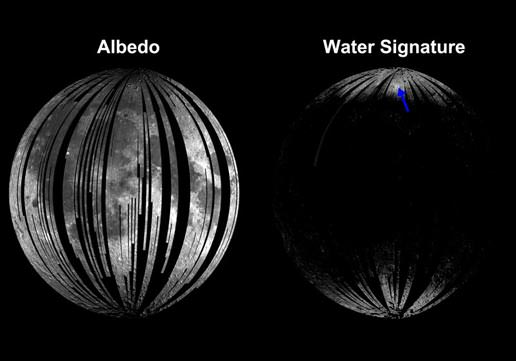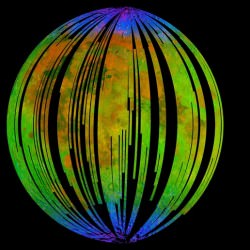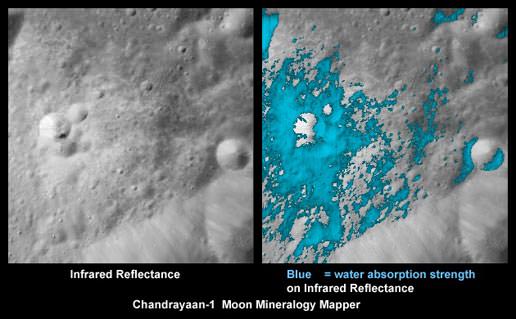[/caption]
The Moon has been turned upside down. Figuratively, of course. La Luna still orbits and phases as it always has, but we are now looking at the moon anew. From this day forward we know the chemistry of the Moon is different than what we have thought for decades, the geology might vary from what is in textbooks today, and the physics of how the solar wind interacts with a rocky body without an atmosphere has implications not yet fully investigated. So, what does this mean for our future human and robotic exploration of our closest companion in space?
“The Moon continues to surprise us,” said Carle Pieters, principal investigator for the Moon Mineralogy Mapper (M cubed) at Thursdays press conference. “Widespread water has been detected on the surface of the Moon. You have to think outside of the box on this. This is not what any of us expected decades ago.”
Immediately, space enthusiasts’ thoughts turn to how finding water on the Moon will make future exploration there so much easier.
“Scientists thought they knew fairly accurately what the surface of the moon was like and these results show that they didn’t – or at least not completely,” said Dr. Chris Welch, astronautics and space systems expert at Kingston University in London. “Finding so much more water could make living on the moon much easier in the future…If there is water on the moon – in whatever form – then we have a potential reservoir that could be used for drinking or to make into hydrogen and oxygen which could be used as rocket propellant. Also, of course, we could use the oxygen to breathe.”
But the message the scientists wanted everyone to take away from today’s press conference is that a combination of water (H2O) and hydroxyl (OH) that resides in upper millimeter of the lunar surface doesn’t actually amount to much. The average amount of water, if extracted, is about a quart (1 liter) of water per ton of surface soil, or about 16 ounces (.5 liters) of water might be present for every 1,000 pounds (450 kg) of surface soil near the moon’s poles. For soil near the equator, only about two tablespoons of water is believed to be present in every 1,000 pounds (450 kg).
“That is truly astounding, and generating much excitement,” said Jim Green, director of the Planetary Science Division at NASA. “But please keep in mind that even the driest deserts on the Earth have more water than are at the poles and the surfaces of the moon.”
So maybe this water on the Moon is not such a big deal.
But there’s still the very real possibility that there could be water ice underneath the regolith on the Moon or buried deep within craters at the poles. Fairly recent (within the past million years) impact craters on the moon were found to have ejecta “rich” with water and hydroxyl, according to M cubed data, which implies recently those molecules are buried under the surface.
Plus the scientists hinted at data showing Goldschmidt Crater at the Moon’s north pole could be filled with water ice.

Additionally, what the scientists at today’s briefing found most astonishing about the new findings is that the water and hydroxyl show up at all latitudes, even at the equator in sunlight, where it is quite hot, and that there are a wide variety of hydroxyl bearing minerals at the surface. This is telling us there are some dynamic processes happening on a moon we thought to be bone dry and basically dead.
There appears to be a cycle of water being created and lost during a lunar day. Without an atmosphere, the moon is exposed to solar wind, which includes hydrogen ions. The hydrogen is able to interact with oxygen in lunar soil to create water molecules. The water appears to be created at night on the Moon, lost during the “hottest” parts of the two-week lunar day; then as it cools near evening, the cycle repeats itself. So, regardless of the type of terrain on the Moon, the entire surface of the moon will be hydrated at least for part of the day. The scientists said similar hydration effects may be present on any body in our solar system that doesn’t have an atmosphere, including asteroids and Mercury.
Those implications are huge for our explorations of other moons and worlds.
But back to the Moon. “Before this press conference, it was thought to be impossible to have water on the surface of the Moon in hot sunlight, especially on the surface at the equator,” said Roger Clark, with the M cubed and Cassini mission.

Could water be a renewable resource on the Moon? If the water is constantly being created, could a devise be built to extract or collect the water? Easy availability of water would have an immense impact on any future human exploration on the Moon, be it brief sorties or permanent colonies.
This is intriguing,” said Pieters, “but we need to go back and re-determine this silicate surface and the vacuum around it. This is an environment we know very little about, and the physics is in its infancy.”
Discussing the implications, Pieters said first, the source of the water needs to be determined, whether it is actually from the solar wind, comets, meteorites, possibly an outgassing from the interior. “There are fundamental questions we need to understand about this silicate body,” she said. “Clearly this has to be a marriage between geology and space physics.”
And what about the “follow the water” mantra NASA has been following in regards to Mars? Could the “where there’s water, there’s life” hypothesis pertain to the Moon? Is there water on the Moon? While these new details about the Moon are groundbreaking, Welch does not believe the new findings show there is or could once have been life on the moon, but he says further research is needed. “There need to be more detailed science missions, preferably with astronauts landing on the moon, to analyse the soil in space.”
Certainly, the upcoming LCROSS impact on the Moon’s south pole will be watched with even greater interest. But what about future exploration?
Will this impel the Constellation Program to continue as planned with a return to the Moon? The Obama administration has some big decision to make in regards to NASA, and it’s hard to imagine this new information about the Moon won’t have some impact on the future path the space agency will take.
We can only hope this news brings more public and congressional interest in NASA’s future.


Visiting the local news website yesterday I found what I considered to be a fail regarding the image they used. I grabbed a screen shot just in case they changed it in the end (they did). Is it Enceladus?
http://two-more-gaps.blogspot.com/2009/09/moon-fail.html
Without taking away from the scientific merit, in practical terms, a better way to characterize what was found is transient outgassing of water molecules – water molecules are formed, and then proceed to leave the surface like they do from the walls of any high-vacuum chamber. Calling it “a kg of water per ton of soil” is misleading, since nowhere can you take a ton of regolith and find a kg of water in it.
It is a transient surface phenomena – you have to take a thin layer of top soil and keep it in its thin-layer form, and keep exposing it to sunlight, and then you can capture some water molecules coming off of it.
As for the number itself (1 kg water per ton of soil):
Assuming 28 days of exposure to high vacuum are enough to bake out the moisture, then we have a steady state – water-in = water-out. (no accumulation)
If this is happening at the top 1 mm of very lightweight soil (1g/cc), and since hydrogen is about 10% of the weight of water, and assuming the conversion efficiency is 100%, then we can infer that the solar particle flux is on the order of 0.1 kg over 1000 m2 over the course of 28 days. Very roughly.
That’s more than I thought it is.
Looking online I found values for solar flux of about 1E8 protons cm-2 s-1.
This means that over 28 days and 1000 m2 we’ll have 1E8*28*24*3600*1E4*1000*1.7E-27 = 0.1 grams of Hydrogen, or 1 gram of water – not 1 kg.
And this is IF the reaction is 100% efficient, meaning every incoming proton gets into a water molecule. Which is not realistic – there must be other things that the protons can do once they hit the surface.
Anyway – 1 kg water in a ton of soil is something you can almost feel with your hand. Solar wind can’t do that.
Just being a skeptic here. I may have gotten my numbers crossed, too.
Well, it’s a bit confusing, I’ll give you that. They have AFAIU reported both a varying surface water component and a static, deeper, and more uniform crystal water component.
The later is what I would expect from astronomical bodies, I never got around to figure how they thought the Moon got so dry by the Theia collision. I assume the collision models can get more realistic now.
The Power of the announcement…
What next…?
Can we improve the efficiency of this process? I would expect the incoming hydrogen ions might be coming in from the sun, so they may have an angular spread of half a degree or less. It would be possible to focus these ions using something like an Einzel electrostatic lens. The Wikipaedia drawing makes it look like a big thing, but it needn’t be much more than wire, and it doesn’t have to be square.
You might still get only a few teaspoons a day, but you might not have to hunt though a ton of regolith to get it.
that’s actually right – since it’s a production process, no need to actually “process the regolith” – however, I don’t see a teaspoon a day coming out of anything short of square kilometer collector…
I think what happened is that they have these surface readings, and someone up the food chain forced them to “put it in terms of pounds water per ton soil” even though it is completely nonsensical, since “water found on the moon” sounds a lot better than “water molecules are briefly formed on the surface during daytime”.
not nice.
I agree there are some missing ingredients here. The OH^- or H_2O [ called HO(H)]here is replenished by the solar wind, and is an integration over area and time of the flux. So the numbers above look fairly reasonable except for a couple of things. The first is that for some reason (heat) the HO(HO collects near the poles, so there is a cos(angle) effect. The other is that the surface gets solar flux half the time, and there is another integrated over an average angle between the line of zenith on the lunar site and the sun. So I would expect there to be an equilibrium wiht far less than .1g, but maybe .01g.
For there should be 1L of HO(H) per ton of regolith (approx 1000m^2) there would have to be some sequestering effect. That this happen near the poles is suggestive. Near the equator the solar heating is probably too much for the HO(H) to accumulate during the day. So if it accumulates near the poles maybe if there is initially none (thinking here of a modeled initial condition) there then by the end of a 14 day lunar “sol” there would be some trapped in the regolith. This is then frozen there during the lunar “night” until the next lunar sol-rise. More of HO(H) accumulates until there is some more or less constant amount which is trapped in the regolith that is a much larger amount than the tiny bit we would expect from a very transient “In & Out” equilibrium effect.
LC
I agree about the 0.1 g being very liberal – it is indeed far lower than that. I missed the night time factor, and didn’t bother with the cosine factor. I was just unhappy with how such a major announcement was handled – the misleading phrasing, the way it was “leaked”. Otherwise I don’t come out of my cave like this, by they started it! 🙂
Once formed, a molecule sits on the surface until a thermal vibration kicks it out. This is high vacuum, so it’s molecular flow – each molecule to itself, so to speak.
Once it pops out, it is close to thermal velocity – very likely to escape. If it doesn’t, however, it hops to another point on the surface, until it hits a cryo-trap near the pole, and so this is not different than the comet mechanism.
Why do we get a higher reading at the poles? It could be the result of a simple continuity condition – the water is produced everywhere, escapes more readily near the equator, but is migrating as a whole towards the poles. So it might just work out mathematically because of that.
I don’t think it gets sequestered at any point however – the time constant for it to get outgassed is very long compared to the numbers observed.
It sounds like water starts getting produced immediately at sunrise, and by the time the ground gets hot, the temperature is high enough to already offset most of the production, so by the time the sun sets, and the ground is still hot, it dries out enough so that “stay over” quantities are negligible.
@CrazyEddieBlogger.
Would there be any implications here for comet tail formation?
I wonder what’s beneath the surface.
Well?
The moon has a very tenuous atmosphere of sorts, not much to speak of. It is mostly sodium I think. So maybe there is a tiny component of water vapor there that might get redeposited near the poles.
Which ever the case there clearly is not enough water for any extensive human habitation there. The total amount of water on the moon might not so much as fill up a small lake. Excitement over this with regards to lunar bases and Tycho-city are probably overblown.
LC
Alright, let me get this straight, we discovered there was water on Mars before we realized there was some on our own Moon.
water, good old water on the moon.
how exciting, I never would have guessed!
thats gotta get NASA’s mojo going again 🙂
Fascinating… Source of ice on Mercury too?
Mr. Sol’s variable neucleosynthesis rates responsible for Ice Ages? On Earth.. or Mars? New images from Mars show water ice near the surface at Mars’ equator.
Ignoramus 🙂
The composition of the moon is different than that of comets – the comets already have a lot of water, and the moon has more oxygen-containing-rocks, BUT you’re 100% correct that similar phenomena (chemical reactions with solar winds) occur everywhere.
For that matter, any NEO out there that is a remnant of the Moon formation episode will generate water molecules in the same manner, so will become a “faint comet”.
Timmy – yes, and for a good reason.
Water on Mars exists in huge quantities – exposed in plain view nearer the poles, and very close (as in several feet) underground in many other places.
In other words, if you were to land on Mars, dig down a foot or so, and use a pick-axe to drudge up a bucketful of ice, you’d have the equivalent of water produced on the moon over several square kilometers (1000 acres) over a month. So it’s not really comparable.
We knew about Water on Mars since we first saw white deposits and measured the temperature to be above where dry ice can exist.
The latest surprise (as of about 10 years ago) is that we’re finding water ice almost everywhere, and evidence of recent short-lived water flows
Right, Mars is a down right water wonderland compared to the moon, and Mars is frankly pretty dry. If you need water on the moon you are better off carrying hydrogen there, which is not terribly heavy even in liquid form, and chemically combine that with oxygenated materials in regolith to make water.
LC
OK, I finally got a lead that cut through some of my own confusion.
The discussion on water in minerals likely goes back to mentionings of a paper from 2008 by Saal et al, where they used new ion microprobe techniques to measure water (and other volatiles) in lunar volcanic rock samples. They got a normal diffusion profile, which means there was water during rock formation, and the quantities (~ 0.8 parts/thousand) were equivalent to mid-ocean magma formation.
HT to Emily Lakdawalla of The Planetary Society, <a href="who also shows graphs on both day and night amounts. The former existence of which is presumably the persistent signal (but then surface originating, at ~ 2 mm max depth) which implications on over all equilibrium I see you already discussed.
All in all a good case of how not to present science by press conference, IMO.
We have discovered water on the moon! I live in the future! 😀
“the quantities (~ 0.8 parts/thousand) “.
Oh uh, that was of course meant to say the calculated initial quantities at bead formation. That article contains a diagram that max out at 0.03 ppt in the center of a typical volcanic glass bead at present day. (And the variation is such that they mention 0.05 ppt as max.)
Not much compared to the surface content, that is.